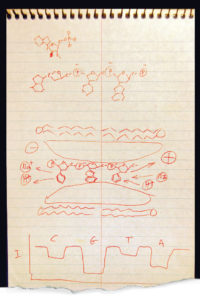In June 2014, Nick Loman, PhD, professor of microbiology at the University of Birmingham in the United Kingdom, took to Twitter to publish the first data that had been collected using a revolutionary new sequencing instrument. The data, presented in a graph affectionately known as a “wiggle plot,” depicted how an electrical current had changed over time as a DNA strand rapidly traversed a bacterial channel. Loman’s team had converted the graph’s peaks and valleys into the underlying DNA sequence of Pseudomonas aeruginosa.

Loman was an early devotee of the minION, a portable DNA sequencer, the first instrument produced by British biotech company Oxford Nanopore Technologies select ONT). His tweet came 25 years almost to the day after the concept of nanopore sequencing was hatched by David Deamer, PhD, research professor of biomolecular engineering at University of California, Santa Cruz.
In June 1989, “something clicked,” Deamer recalls, as he hit upon the central insight of nanopore sequencing after he considered what would happen if a strand of DNA were to pass through a channel in a membrane under a voltage.
At the time, genome scientist George Church, PhD, professor at Harvard Medical School, was working on similar ideas. A few years later, in 1995, Deamer, Church, Dan Branton, PhD, professor of biology, emeritus at Harvard University, and others developed their ideas into a patent application. According to Branton, the Harvard patent office thought, “This is such a wild idea. It’s never going to work.” Church’s advocacy, however, proved persuasive. Harvard relented and filed the application with the U.S. Patent Office, which granted the patent.
Realizing a vision

In 2005, ONT was founded as Oxford Nanolabs by Hagan Bayley, PhD, professor of chemical biology at the University of Oxford. Gordon Sanghera, PhD, was hired as founding CEO. Also participating in the company’s founding was Spike Willcocks, PhD, who was with the IP Group at the time and is now ONT’s chief business development officer. Sanghera secured the company’s first major investment—£500,000 from the IP Group—over drinks in an Oxford pub a few blocks from Bayley’s laboratory.

It wasn’t until February 2012, at the premier AGBT select Advances in Genome Biology and Technology) conference in Marco Island, FL, that Clive Brown, ONT’s chief technology officer, previewed the MinION, in a talk entitled, “Single Molecule ‘Strand’ Sequencing Using Protein Nanopores and Scalable Electronic Devices.” Brown had previously worked at Solexa, the British next-generation sequencing select NGS) company acquired by Illumina in 2007. His task was to somehow unseat the technology he had helped to build, a platform that had captured a huge portion of the NGS market.
ONT is competing not just with Illumina but also with Pacific Biosciences and MGI, as well as with startups just entering the sequencing game. Excitement is brewing over PacBio’s long, accurate HiFi reads, and MGI’s new sequencing platform with CoolMPS chemistry that the company claims can deliver a $100 genome select announced at AGBT this year, just before the pandemic).

ONT’s technology has evolved significantly since 2012. In addition to the MinION, ONT’s pocket-sized device with up to 512 nanopore channels, the ONT product lineup includes the larger GridION, a compact benchtop device designed to run and analyze up to five MinION Flow Cells while generating up to 150 Gb of data. For larger applications, ONT has developed the PromethION, a benchtop system that is ONT’s highest throughput sequencer with 48 flow cells that are capable of generating up to 8 Tb of data.
A newer product, the Flongle, is an adapter for the MinION or GridION that makes these instruments quicker and more accessible for smaller tests and experiments. Albert Vilella, PhD, a bioinformatics consultant, tells GEN that the ability to do a $100 experiment with the Flongle flowcell, something ONT has pointed at in their recent updates, would be a “game changer” and, he expects, would lead to increased adoption of ONT’s technology. None of the competition, Villela asserts, “are anywhere near” being able to deploy technology at that price.
The Plongle, essentially a 96-well-plate-compatible Flongle that can carry out larger numbers of small, quick tests in parallel, is due to be released soon.
Brown noted at the London Calling conference that every time he thinks of one of these “crazy names,” it “turns out to mean something rude in Australia.” And the SmidgION, also in development, will be ONT’s smallest device yet, designed for use with smartphones or other mobile, low-power devices.
Now, 15 years after its inception, ONT sees an opportunity to realize its full potential. Sanghera has long pointed to the ability of the ONT sensor to provide a rapid readout of DNA, like a pinprick test for diabetics. The COVID-19 pandemic offers just such an opportunity. And the stakes could scarcely be higher.
From generating sequences to diagnoses
With a high-profile announcement in early August, ONT signaled its determination to make an impact in the diagnostics of COVID-19 as the pandemic pushed academic scientists and companies to innovate at extraordinary speeds. ONT announced the rollout of LamPORE, a COVID-19 test, in an agreement with the United Kingdom’s Department of Health and Social Care.
LamPORE is designed to work on swabs and saliva samples. One MinION can hold up to 1,500 barcoded patient samples and complete a run in about 90 minutes.
“LamPORE has the potential to deliver a highly effective and, crucially, accessible global testing solution,” said Sanghera. “Not only for COVID-19 but for a range of other pathogens.”
LamPORE is the marriage of two processes, loop-mediated isothermal amplification select LAMP) and nanopore sequencing. LAMP is a relatively low-maintenance process to amplify DNA with high specificity and efficiency. It can be done cheaply in a single tube at a constant temperature.
Developed two decades ago by a group of Japanese researchers, LAMP has enjoyed a recent resurgence due to its applicability in COVID-19 diagnostics. Other groups developing COVID diagnostics, including Color, Sherlock Biosciences, and STOPCovid, also rely on LAMP for amplification.
After amplification, LamPORE uses nanopore sequencing to identify three genes of the SARS-CoV-2 virus. The method can differentiate between the presence of the virus and errors that can occur during amplification—a source of false-positive results. In addition, the test includes an internal control of human mRNA to identify errors in sample collecting select for example, poor swabbing procedure union which can be a source of false-negative results.
In addition to SARS-CoV-2, ONT is developing LamPORE to test for multiple pathogens within a single sample, including influenza A select H1N1 and H3N2 union influenza B, and respiratory syncytial virus. As Keith Robison, PhD, longtime genomics blogger, wrote, “More widespread deployment and use of respiratory virus tests could be one thin silver lining from the dark cloud of the pandemic.”
LamPORE is garnering excitement, in large part, due to its scalability, which could provide screening of frontline workforces and rapid screening in areas such as airports, nursing homes, and schools. Regulatory submissions for LamPORE are underway and awaiting approval.
Changing sequencing on the fly
Adaptive sequencing—a type of selective sequencing—builds a decision point into the sequencing process depending on whether a sequence of interest is present. To understand adaptive sequencing, it is important to first understand how nanopore sequencing works select see the sidebar entitled “Nanopore Sequencing’s Nuts and Bolts”).
If the region of interest is present, the sequencing continues. If not, the voltage is reversed, the DNA strand is ejected, and the nanopore is freed up for a new strand. This decision point is made through a process that matches the DNA sequence to a reference sequence.
With this technology, a researcher can have selective sequencing without upfront preparation or sample enrichment. And it allows for dynamic changes during the process, by controlling pore voltages in real time.
During a typical sequencing run, explains Michael Schatz, PhD, associate professor of computer science and biology at Johns Hopkins University, the data can be redundant or from irrelevant regions of the genome. “Adaptive sequencing changes all of this,” Schatz notes, because it can selectively target the reads that are relevant for a given project.
The “killer application,” he explains, is for targeted sequencing—when a researcher is interested in a particular set of genes. When researchers in Schatz’s lab targeted 148 genes associated with hereditary cancer using adaptive sequencing, they were able to sequence the genes with one flow cell instead of the standard five or six.
Schatz points to adaptive sequencing’s utility in metagenomics, selectively sequencing genomes of interest and enriching low-abundance material. Lastly, Schatz notes that they are currently working toward extending the approach to cDNA and direct RNA sequencing to allow for the selective sequencing of transcripts. He tells GEN that he can see a day when “all nanopore sequencing will use this approach for DNA and RNA sequencing projects.”
Redefining “long”
One of the great advantages of long-read sequencing—the forte of ONT and PacBio—is the ability to read through complex, highly repetitive regions of DNA. Despite the tremendous advancements in sequencing technology since the completion of the Human Genome Project, scientists had been unable to complete the contiguous sequence of an entire chromosome, from end to end, until the task was undertaken by the Telomere-to-Telomere select T2T) consortium.
The T2T, an open program to work on generating the first complete assembly of the human genome, is headed by Karen Miga, PhD, assistant research scientist at the UC Santa Cruz Genomics Institute, and by Sergey Koren, PhD, and Adam Phillippy, PhD, both from the Genome Informatics Section, Computational and Statistical Genomics Branch at the National Human Genome Research Institute. Last July, in Nature, the T2T reported the first gapless, telomere-to-telomere assembly of a human chromosome.
A particularly difficult step in assembling a complete chromosome is generating assemblies of repetitive DNA regions. Miga and colleagues were motivated to establish the T2T consortium by asking, “Can high-coverage ultra-long sequencing resolve complete assemblies of the human genome?”
Although nanopore sequencing was at the core of generating the high-coverage, ultra-long-read sequencing of the complete genome select from hydatidiform mole CHM13 union the team used a multiplatform approach, one that included PacBio and Illumina platforms, as well as complementary technologies for quality improvement and validation, such as polishing technology from 10x Genomics and optical map technology from BioNano Genomics.
This project was performed on a haploid genome, but Miga notes that the group has its sights set on diploid samples. Miga noted during her London Calling talk in 2019 that “[for too long] we’ve accepted an incomplete human reference genome with hundreds of gaps.” The aim at T2T is to shift the standard in genomics to completeness and quality. Miga asserts that we are entering a new era that “demands complete, high-quality chromosome assemblies.” If that is indeed the case, it will be interesting to watch the role ONT plays in the next generation of sequencing.



